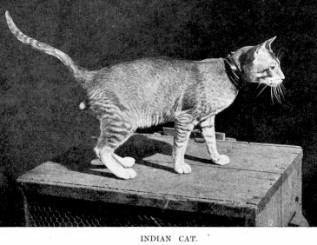|
|
|
|
Bunny Cat (1902) |
Manx Champion “Katzejammer,” Manx Champion “Bonhaki,” Abyssinian “Sedgemere Peaty.” (1902) |
SHORTHAIRED CATS OF THE 19TH CENTURY - DIVERSE BREEDS AND GENERAL COMMENTS
Various Shorthairs (From “Animal Life and the World of Nature” (Vol 1, 1902-1903))
IT is probable that the common domestic cat is mainly derived from the Felis chaus of Africa. A noticeable reversion to the original type is to be found in those cats commonly known as Abyssinian or Bunny cats, many of which exactly resemble what one would reasonably expect the Egyptian cat to become after some generations of domestic life. We recently saw an excellent specimen of exactly the colour of a Felis chaus, even carrying the resemblance so far as to exhibit on each car a tiny tuft of hair, which is seen in the Chaus cat, and marks the gradual approach to the Lyncine group.
|
|
|
|
Bunny Cat (1902) |
Manx Champion “Katzejammer,” Manx Champion “Bonhaki,” Abyssinian “Sedgemere Peaty.” (1902) |
A pretty group of departed stars of the catty world is depicted on the opposite page. These cats were Manx Champion “Katzejammer,” Manx Champion “Bonhaki,” and the Abyssinian “Sedgemere Peaty.” Since “Peaty’s” death, no really first-class Abyssinian has been exhibited in this country.
There is a very great difference between a Manx cat and a tailless cat, though the difference does not seem to be appreciated by certain “judges” who gaily award prizes to cats woefully lacking in Manx quality, if only they are large and well-marked. Of late years, however, Manx owners have livened up, and competent judges have more often been appointed. A great characteristic of the Manx is its immense length of hind-leg, which gives it a rabbit-like appearance, especially when in motion. This is excellently shown in our portrait of “King Clinkie,” Mrs. H. C. Brooke’s Manx, which won two first prizes and the championship at the last show held by the National Cat Club.
|
|
|
|
Manx "King Clinkie" (1902) |
Australian Cat (1902) |
There is, of course, no breed of cats indigenous to Australia, but, amongst others, a strain of cats has formed itself exhibiting very marked characteristics which. however, lead us to agree with an American author who asserts the probability that they are derived from imported cats of Eastern origin, possibly Siamese. Very curious is the little grey spotted cat here shown, though unhappily the position does not bring out his great length of hind leg nor his peculiar rather long and tiger-shaped nose, which, seen sideways, gives him a queer expression. He has, like his mother and his brothers and sisters, a triple kink in his tail.
For all the photographs of cats on these two pages we are indebted to Mrs. H. C. Brooke, who kindly allowed her pets to “sit” to our photographer. The group of champions, however, is from a photograph lent to us by their owner; the three others were taken especially for Animal Life.

Some of the varieties of the domestic cat of India of India are evidently derived from the smaller wild breeds of that country. From what variety is derived the peculiar cat whose photograph we give (lent us by Messrs. Harmsworth) it is hard to say. The colour of this cat above is a beautiful light chestnut red, fading through various shades of golden yellow to white underneath. On the sides he is beautifully pencilled, and faintly striped on the legs. The forehead is wrinkled like that of a Chow dog; head, long, shallow and pointed, legs very long and slender, the tail of great length and tapering like that of a pointer. The coat is extremely short; ears thin, large and mobile; eyes, piercing in expression, of clear amber colour. His calls are varied, and somewhat resemble the raucous voice of the Siamese cat. The most careless observer will at once note certain structural features in which this cat differs from the common cat. He has won many first prizes, and is the property of Mrs. H.C. Brooke, of Welling.